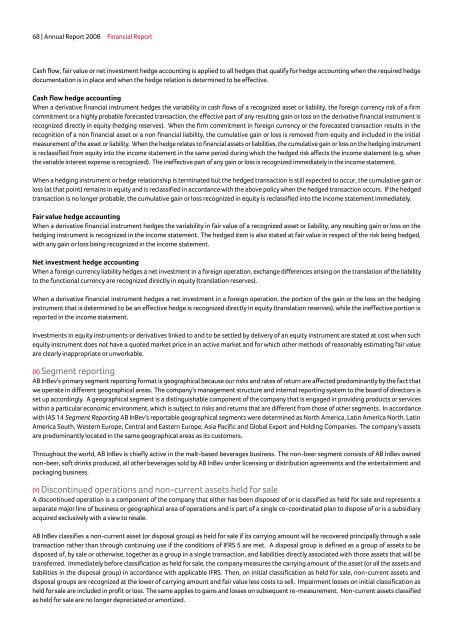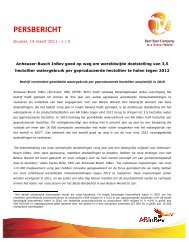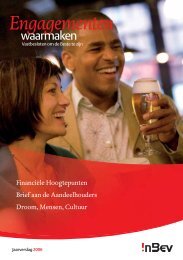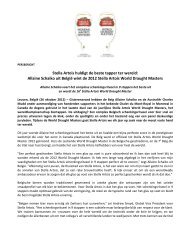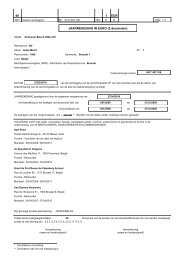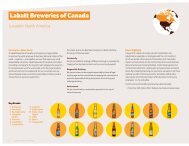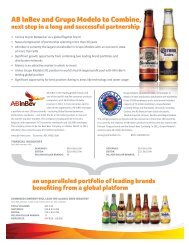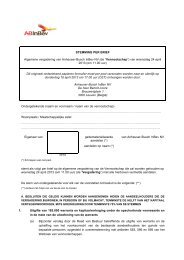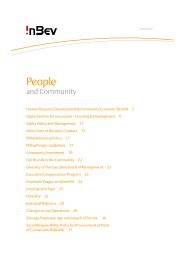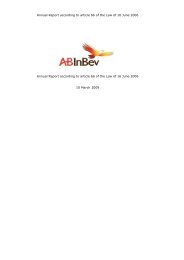The Best Beer Company in a Better World - Anheuser-Busch InBev
The Best Beer Company in a Better World - Anheuser-Busch InBev
The Best Beer Company in a Better World - Anheuser-Busch InBev
You also want an ePaper? Increase the reach of your titles
YUMPU automatically turns print PDFs into web optimized ePapers that Google loves.
68 | Annual Report 2008 F<strong>in</strong>ancial Report<br />
Cash flow, fair value or net <strong>in</strong>vestment hedge account<strong>in</strong>g is applied to all hedges that qualify for hedge account<strong>in</strong>g when the required hedge<br />
documentation is <strong>in</strong> place and when the hedge relation is determ<strong>in</strong>ed to be effective.<br />
Cash flow hedge account<strong>in</strong>g<br />
When a derivative f<strong>in</strong>ancial <strong>in</strong>strument hedges the variability <strong>in</strong> cash flows of a recognized asset or liability, the foreign currency risk of a firm<br />
commitment or a highly probable forecasted transaction, the effective part of any result<strong>in</strong>g ga<strong>in</strong> or loss on the derivative f<strong>in</strong>ancial <strong>in</strong>strument is<br />
recognized directly <strong>in</strong> equity (hedg<strong>in</strong>g reserves). When the firm commitment <strong>in</strong> foreign currency or the forecasted transaction results <strong>in</strong> the<br />
recognition of a non f<strong>in</strong>ancial asset or a non f<strong>in</strong>ancial liability, the cumulative ga<strong>in</strong> or loss is removed from equity and <strong>in</strong>cluded <strong>in</strong> the <strong>in</strong>itial<br />
measurement of the asset or liability. When the hedge relates to f<strong>in</strong>ancial assets or liabilities, the cumulative ga<strong>in</strong> or loss on the hedg<strong>in</strong>g <strong>in</strong>strument<br />
is reclassified from equity <strong>in</strong>to the <strong>in</strong>come statement <strong>in</strong> the same period dur<strong>in</strong>g which the hedged risk affects the <strong>in</strong>come statement (e.g. when<br />
the variable <strong>in</strong>terest expense is recognized). <strong>The</strong> <strong>in</strong>effective part of any ga<strong>in</strong> or loss is recognized immediately <strong>in</strong> the <strong>in</strong>come statement.<br />
When a hedg<strong>in</strong>g <strong>in</strong>strument or hedge relationship is term<strong>in</strong>ated but the hedged transaction is still expected to occur, the cumulative ga<strong>in</strong> or<br />
loss (at that po<strong>in</strong>t) rema<strong>in</strong>s <strong>in</strong> equity and is reclassified <strong>in</strong> accordance with the above policy when the hedged transaction occurs. If the hedged<br />
transaction is no longer probable, the cumulative ga<strong>in</strong> or loss recognized <strong>in</strong> equity is reclassified <strong>in</strong>to the <strong>in</strong>come statement immediately.<br />
Fair value hedge account<strong>in</strong>g<br />
When a derivative f<strong>in</strong>ancial <strong>in</strong>strument hedges the variability <strong>in</strong> fair value of a recognized asset or liability, any result<strong>in</strong>g ga<strong>in</strong> or loss on the<br />
hedg<strong>in</strong>g <strong>in</strong>strument is recognized <strong>in</strong> the <strong>in</strong>come statement. <strong>The</strong> hedged item is also stated at fair value <strong>in</strong> respect of the risk be<strong>in</strong>g hedged,<br />
with any ga<strong>in</strong> or loss be<strong>in</strong>g recognized <strong>in</strong> the <strong>in</strong>come statement.<br />
Net <strong>in</strong>vestment hedge account<strong>in</strong>g<br />
When a foreign currency liability hedges a net <strong>in</strong>vestment <strong>in</strong> a foreign operation, exchange differences aris<strong>in</strong>g on the translation of the liability<br />
to the functional currency are recognized directly <strong>in</strong> equity (translation reserves).<br />
When a derivative f<strong>in</strong>ancial <strong>in</strong>strument hedges a net <strong>in</strong>vestment <strong>in</strong> a foreign operation, the portion of the ga<strong>in</strong> or the loss on the hedg<strong>in</strong>g<br />
<strong>in</strong>strument that is determ<strong>in</strong>ed to be an effective hedge is recognized directly <strong>in</strong> equity (translation reserves), while the <strong>in</strong>effective portion is<br />
reported <strong>in</strong> the <strong>in</strong>come statement.<br />
Investments <strong>in</strong> equity <strong>in</strong>struments or derivatives l<strong>in</strong>ked to and to be settled by delivery of an equity <strong>in</strong>strument are stated at cost when such<br />
equity <strong>in</strong>strument does not have a quoted market price <strong>in</strong> an active market and for which other methods of reasonably estimat<strong>in</strong>g fair value<br />
are clearly <strong>in</strong>appropriate or unworkable.<br />
(X) Segment report<strong>in</strong>g<br />
AB <strong>InBev</strong>’s primary segment report<strong>in</strong>g format is geographical because our risks and rates of return are affected predom<strong>in</strong>antly by the fact that<br />
we operate <strong>in</strong> different geographical areas. <strong>The</strong> company’s management structure and <strong>in</strong>ternal report<strong>in</strong>g system to the board of directors is<br />
set up accord<strong>in</strong>gly. A geographical segment is a dist<strong>in</strong>guishable component of the company that is engaged <strong>in</strong> provid<strong>in</strong>g products or services<br />
with<strong>in</strong> a particular economic environment, which is subject to risks and returns that are different from those of other segments. In accordance<br />
with IAS 14 Segment Report<strong>in</strong>g AB <strong>InBev</strong>’s reportable geographical segments were determ<strong>in</strong>ed as North America, Lat<strong>in</strong> America North, Lat<strong>in</strong><br />
America South, Western Europe, Central and Eastern Europe, Asia Pacific and Global Export and Hold<strong>in</strong>g Companies. <strong>The</strong> company’s assets<br />
are predom<strong>in</strong>antly located <strong>in</strong> the same geographical areas as its customers.<br />
Throughout the world, AB <strong>InBev</strong> is chiefly active <strong>in</strong> the malt-based beverages bus<strong>in</strong>ess. <strong>The</strong> non-beer segment consists of AB <strong>InBev</strong> owned<br />
non-beer, soft dr<strong>in</strong>ks produced, all other beverages sold by AB <strong>InBev</strong> under licens<strong>in</strong>g or distribution agreements and the enterta<strong>in</strong>ment and<br />
packag<strong>in</strong>g bus<strong>in</strong>ess.<br />
(Y) Discont<strong>in</strong>ued operations and non-current assets held for sale<br />
A discont<strong>in</strong>ued operation is a component of the company that either has been disposed of or is classified as held for sale and represents a<br />
separate major l<strong>in</strong>e of bus<strong>in</strong>ess or geographical area of operations and is part of a s<strong>in</strong>gle co-coord<strong>in</strong>ated plan to dispose of or is a subsidiary<br />
acquired exclusively with a view to resale.<br />
AB <strong>InBev</strong> classifies a non-current asset (or disposal group) as held for sale if its carry<strong>in</strong>g amount will be recovered pr<strong>in</strong>cipally through a sale<br />
transaction rather than through cont<strong>in</strong>u<strong>in</strong>g use if the conditions of IFRS 5 are met. A disposal group is def<strong>in</strong>ed as a group of assets to be<br />
disposed of, by sale or otherwise, together as a group <strong>in</strong> a s<strong>in</strong>gle transaction, and liabilities directly associated with those assets that will be<br />
transferred. Immediately before classification as held for sale, the company measures the carry<strong>in</strong>g amount of the asset (or all the assets and<br />
liabilities <strong>in</strong> the disposal group) <strong>in</strong> accordance with applicable IFRS. <strong>The</strong>n, on <strong>in</strong>itial classification as held for sale, non-current assets and<br />
disposal groups are recognized at the lower of carry<strong>in</strong>g amount and fair value less costs to sell. Impairment losses on <strong>in</strong>itial classification as<br />
held for sale are <strong>in</strong>cluded <strong>in</strong> profit or loss. <strong>The</strong> same applies to ga<strong>in</strong>s and losses on subsequent re-measurement. Non-current assets classified<br />
as held for sale are no longer depreciated or amortized.


